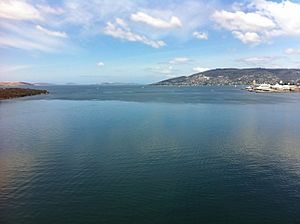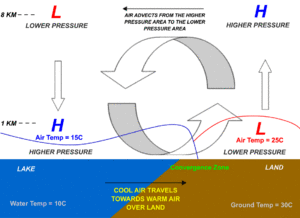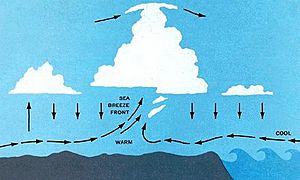Sea breeze facts for kids

A sea breeze is a wind that blows from a large body of water, like an ocean or a big lake, towards the land. It happens because land heats up faster than water when the sun shines. This creates differences in air pressure. Sea breezes are common along coasts after the sun rises.
The opposite is a land breeze. This wind blows from the land towards the water. Land cools down faster than water after the sun sets. So, the wind changes direction at night. Both sea and land breezes are important for the weather near coasts. Sometimes, people also use the term "offshore wind" for any wind over open water.
Wind farms are often built near coasts. This is because they can use the daily changes in wind speed from sea and land breezes. Some wind farms are built very close to the shore in shallow waters. These are called nearshore wind farms. They are designed to use both sea and land breezes. Other wind farms are built further out at sea. They usually rely on stronger, more constant winds, not just the daily breezes.
Why Sea Breezes Happen
The sea warms up much slower than the land. This is because water needs more energy to change its temperature. As the sun heats the land, the air above it also gets warm. This warm air expands and becomes lighter. Lighter air creates lower air pressure over the land near the coast.
At the same time, the air above the sea stays cooler. Cooler air is heavier and creates higher air pressure. Because air always moves from high pressure to low pressure, the cooler air from the sea starts to blow towards the warmer, lower-pressure air over the land. This is what we call a sea breeze.
The stronger the difference in temperature between the land and the sea, the stronger the sea breeze will be. If there is already a strong wind blowing from the land towards the sea, a sea breeze might not be able to form.
How Sea Breezes Affect Weather
A sea-breeze front is like a boundary where the cool air from the sea meets the warmer air from the land. Think of it as a mini cold front. When this front is strong, it can create fluffy clouds called cumulus clouds. If the air is also humid (full of moisture) and unstable, this front can even cause thunderstorms.
If the wind high up in the sky blows in the same direction as the sea breeze, the weather will usually stay nice and clear for the rest of the day. As the warm air keeps rising at the front, and cool air keeps moving in, the sea-breeze front slowly moves further inland. How fast it moves depends on the main wind direction and how big the temperature difference is between the land and the sea.
At night, the land cools down faster than the sea. This reverses the whole process. The land becomes cooler than the sea, and the wind starts blowing from the land towards the sea. This is called a land breeze.
Images for kids
-
Sea breeze meeting in Cuba. The northern sea breeze meets the southern sea breeze, creating a clear line of cumulus clouds.
See also
 In Spanish: Brisa para niños
In Spanish: Brisa para niños





